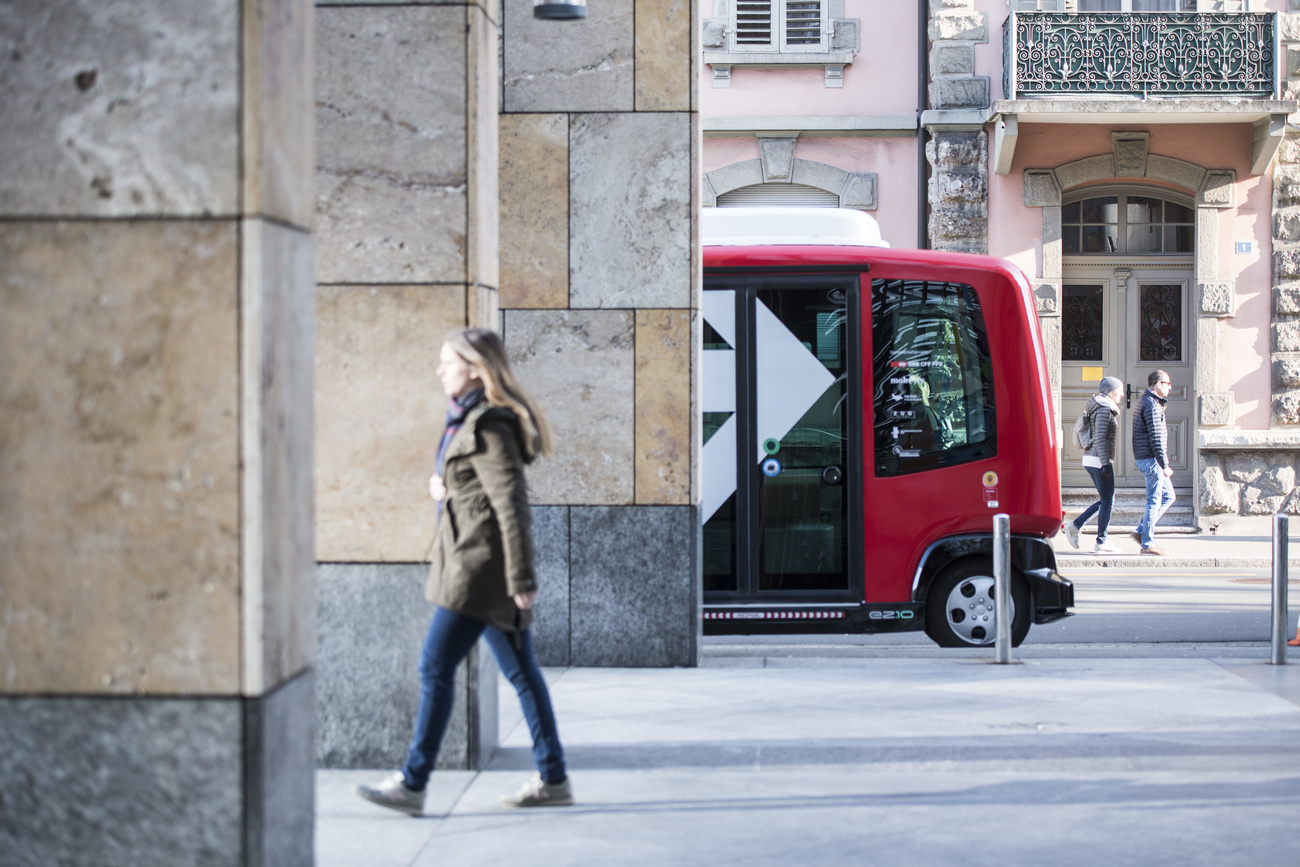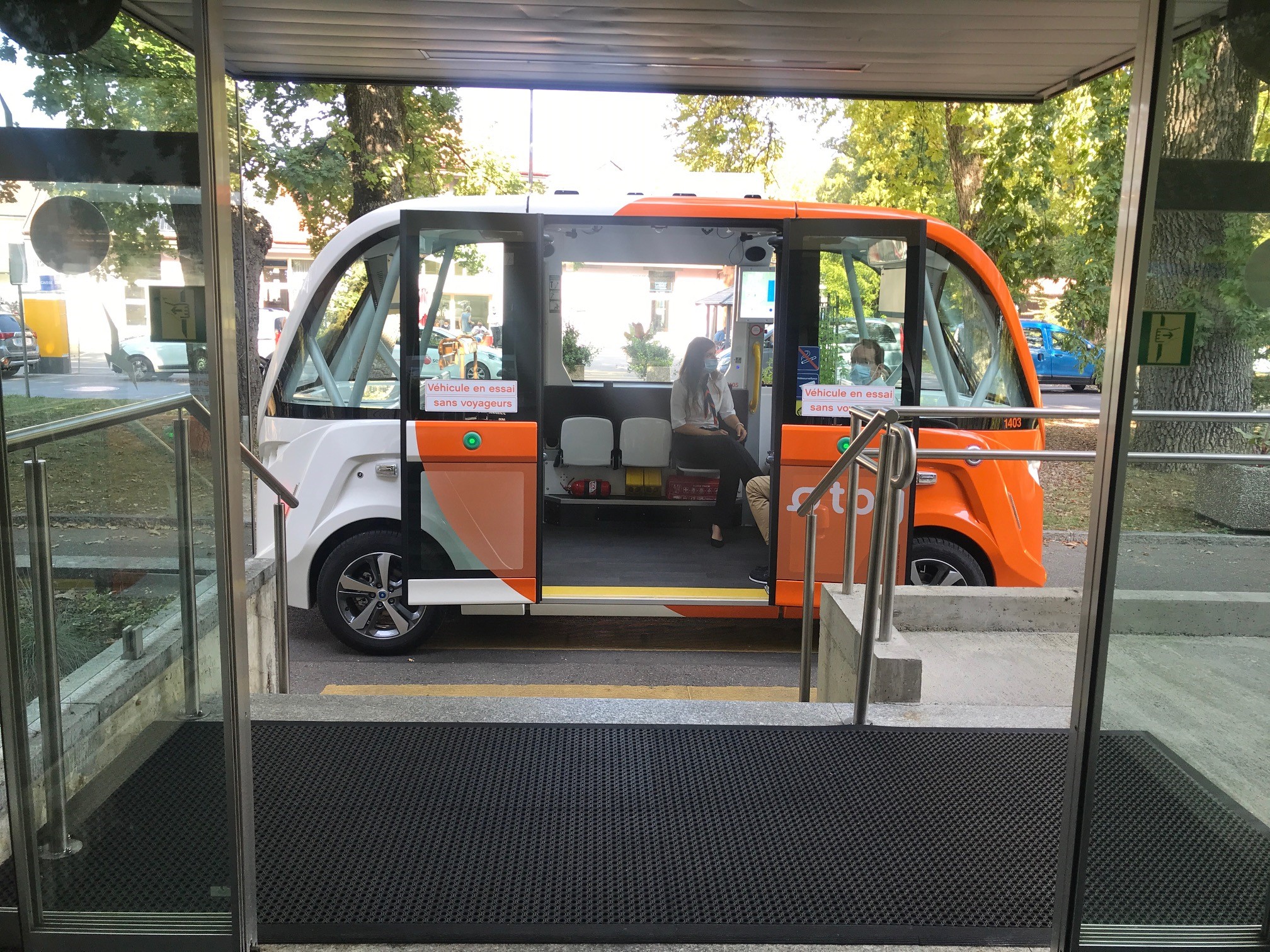Explainer: Switzerland gears up for driverless transport era

Automated vehicles, which are controlled by software rather than physical drivers, have been given the green light to operate on Swiss roads from March this year. What impact will this have, and can we expect to see a flood of driverless cars any time soon?
Following years of controlled trials, the Swiss government has decided that driverless vehicles can meet highway safety requirements under certain conditions (see below).
+ Switzerland greenlights self-driving cars on motorways
Autonomous transport is welcomed by the Swiss authorities as bringing potential improvements to the public transport system and as a likely antidote to traffic jams and accidents caused by careless human drivers. Many other countries worldwide have reached the same conclusion.
SWI swissinfo.ch examines where Switzerland stands on autonomous transport and where the arrival of driverless vehicles could lead us.
What will change in March on Swiss roads?
In December 2024, the government approved a new phase in the gradual introduction of driverless vehicles.
+ Read about the slow but steady progress of driverless buses
From March 1, 2025, cars can operate on Swiss motorways using assisted driving systems that allow the vehicle to autonomously steer and control the speed and braking. But drivers must be continuously ready to re-take control if needed.
Cantons will have the authority to approve certain routes for automated vehicles that operate without a human driver, which are remotely monitored by a control centre. These vehicles will typically be buses, taxis or delivery vans.
+ Zurich airport tests self-driving shuttle buses
Automated parking, without the presence of the driver, will be permitted at designated car parks and parking zones.
“The borders have been extended for autonomous transport in Switzerland,” said Bettina Zahnd, head of road traffic safety at consultancy group EBP Switzerland.
How does Switzerland compare with other countries?
Autonomous vehicle pilot projects and updates to legislation have also taken place in several countries worldwide, including most European states.
China and some states and cities in the United States have pioneered the introduction of vehicles that operate without a human driver (so-called Level 4 automation, see box below).
In 2020, Waymo became the first operator to be given permission to operate a taxi service without a driver in Phoenix. Two years later, Baidu was given the green light to operate its fleet in the Chinese cities of Wuhan and Chongqing.

More
On the road to regulating self-driving cars
Since then, both countries have seen an expansion of different fleets driving in a growing number of cities.
In the last two years Japan, Singapore, the United Arab Emirates and Germany have also seen licences issued for Level 4 vehicles on public roads.
The Swiss government has been handing out permits for driverless vehicle testsExternal link under strict safety conditions since awarding licences to Swisscom and Swiss Post in 2015.
Following a revision of the Road Traffic Act in 2023, the federal authorities now feel comfortable allowing a greater range of autonomous mobility on the roads.
What are the next steps in Switzerland?
Switzerland’s 26 cantons will now assume responsibility for coordinating automated transport systems alongside regular vehicle traffic.
“We are entering a transition stage to get an understanding of what this ordinance means in practice. It’s one thing to see what it means on paper, but the reality can often be a bit different when ideas are put into place,” said Martin Neubauer, lead strategist at the Swiss Association for Automated Mobility (SAAM).
Bettina Zahnd agrees that there is still much to learn in the next phase of automated transport. “This opens the way to more advanced pilot projects with real automated vehicles to gain experience about how they operate within the topography, streets, signage and traffic flows in Switzerland,” she said.

More
Driverless on demand shuttles in training
“Automated transport technology in Switzerland is at present a perfect fit for improving public transport services in remote regions. We will probably have to wait several years before we see it reducing traffic jams and accidents,” Zahnd added.
Neubauer, who plays a leading role in the PostBus project to introduce driverless buses into the public transport system, says Switzerland has different priorities to other countries.
“The focus is less on ride-hailing taxis, as in San Francisco, but on ride-sharing vehicles that onboard as many passengers as possible,” he said.
Will driverless cars ever dominate Swiss streets?
It will take many more years before cars without human drivers become a common feature or threaten to overtake the number of conventional vehicles.
“By 2030 we could have around 100 Level 4 autonomous vehicles on Swiss public roads,” predicts Neubauer. “By 2035 this number could have increased to a few thousand vehicles. We probably won’t see level 5 completely autonomous transport until 2035 at the earliest.”
Part of the reason is that there is still much to be learned about the impact of such technology on the roads before car manufacturers would be willing to bet large on automated cars.
Chinese and US car makers are currently leading the race to produce fleets of automated vehicles, while their European counterparts are falling behind in electric vehicle production. They could struggle to keep pace with the competition in the automated vehicle sector.
The other potential road bump is public acceptance of vehicles without drivers.
A 2017 survey carried out by EBP on behalf of the Swiss Telecommunication Association suggested a general acceptance among the population of systems that assisted drivers, but the overwhelming majority of respondents did not see the sense of vehicles without drivers.
The behaviour of commuters in Switzerland might also have a say in how many people use driverless cars for their private journeys, said Zahnd.
“I don’t think the public is waiting with bated breath for driverless cars,” she said. “Car passengers don’t work on their laptops like they do on trains. Switzerland has very good public transport system, so if people want to work in transit, they use the train rather than their car.”
What are the pros and cons of autonomous transport?
“Automated vehicles will make road traffic safer, improve traffic flow and permit the more efficient utilisation of the available capacities,” reads a Transport of the Future 2060 report published by the transport ministryExternal link in 2020.
Optimising Switzerland’s road capacity has become even more paramount since voters rejected the government’s plans to expand the motorway network last November.
Driverless vehicles could also improve public transport, particularly in remote areas, by providing shuttle services to and from train stations, the report predicts.
Furthermore, it is hoped that the use of automated driver systems will reduce the number of road accidents caused by human error.
But the report also points out some likely drawbacks. “Automated vehicles will reduce, though not entirely do away with, the need for drivers of heavy goods vehicles, buses and taxis”, reads the Transport of the Future report. And the desired effect of promoting car-pooling could negatively impact car sales by reducing the number of vehicles on the road.
SAE International, a US body that draws up technical standards, has developed a taxonomy to describe automation systems on vehicles.
Level 0: Systems that provide warning systems or automatic emergency braking to assist, but not take over from the driver.
Level 1: Systems that provide steering or speed and braking support to the driver who remains at the wheel.
Level 2: Features that offer both steering and speed and braking support at the same time to the driver who remains at the wheel (partial automation)
Level 3: Automated driving in limited conditions. The human driver must be ready to take over control when prompted.
Level 4: Fully autonomous without a human driver, but only in approved areas and with remote human oversight.
Level: The vehicle is fully autonomous and operates itself without any human assistance.
Edited by Virginie Mangin/sb

In compliance with the JTI standards
More: SWI swissinfo.ch certified by the Journalism Trust Initiative









You can find an overview of ongoing debates with our journalists here . Please join us!
If you want to start a conversation about a topic raised in this article or want to report factual errors, email us at english@swissinfo.ch.